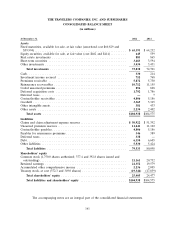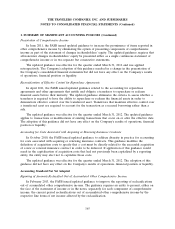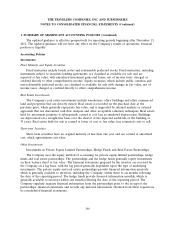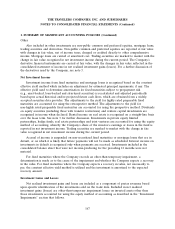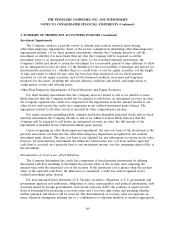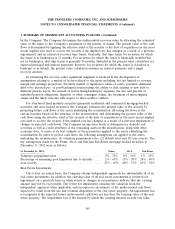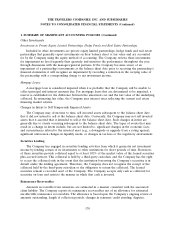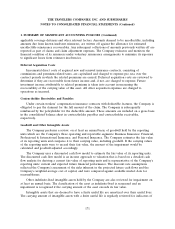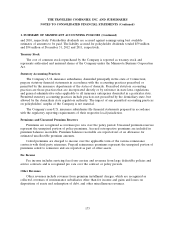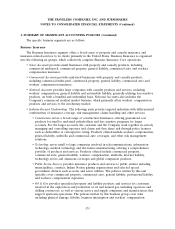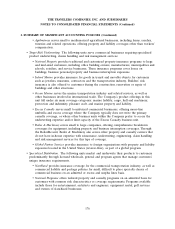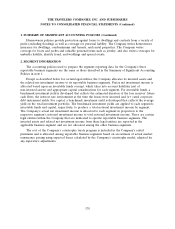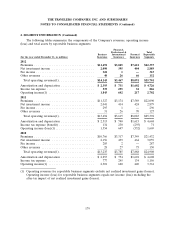Travelers 2012 Annual Report Download - page 181
Download and view the complete annual report
Please find page 181 of the 2012 Travelers annual report below. You can navigate through the pages in the report by either clicking on the pages listed below, or by using the keyword search tool below to find specific information within the annual report.
THE TRAVELERS COMPANIES, INC. AND SUBSIDIARIES
NOTES TO CONSOLIDATED FINANCIAL STATEMENTS (Continued)
1. SUMMARY OF SIGNIFICANT ACCOUNTING POLICIES (Continued)
by the Company. The Company determines the undiscounted recovery value by allocating the estimated
value of the issuer to the Company’s assessment of the priority of claims. The present value of the cash
flows is determined by applying the effective yield of the security at the date of acquisition (or the most
recent implied rate used to accrete the security if the implied rate has changed as a result of a previous
impairment) and an estimated recovery time frame. Generally, that time frame for securities for which
the issuer is in bankruptcy is 12 months. For securities for which the issuer is financially troubled but
not in bankruptcy, that time frame is generally 24 months. Included in the present value calculation are
expected principal and interest payments; however, for securities for which the issuer is classified as
bankrupt or in default, the present value calculation assumes no interest payments and a single
recovery amount.
In estimating the recovery value, significant judgment is involved in the development of
assumptions relating to a myriad of factors related to the issuer including, but not limited to, revenue,
margin and earnings projections, the likely market or liquidation values of assets, potential additional
debt to be incurred pre- or post-bankruptcy/restructuring, the ability to shift existing or new debt to
different priority layers, the amount of restructuring/bankruptcy expenses, the size and priority of
unfunded pension obligations, litigation or other contingent claims, the treatment of intercompany
claims and the likely outcome with respect to inter-creditor conflicts.
For structured fixed maturity securities (primarily residential and commercial mortgage-backed
securities and asset-backed securities), the Company estimates the present value of the security by
projecting future cash flows of the assets underlying the securitization, allocating the flows to the
various tranches based on the structure of the securitization, and determining the present value of the
cash flows using the effective yield of the security at the date of acquisition (or the most recent implied
rate used to accrete the security if the implied rate has changed as a result of a previous impairment or
changes in expected cash flows). The Company incorporates levels of delinquencies, defaults and
severities as well as credit attributes of the remaining assets in the securitization, along with other
economic data, to arrive at its best estimate of the parameters applied to the assets underlying the
securitization. In order to project cash flows, the following assumptions are applied to the assets
underlying the securitization: (1) voluntary prepayment rates, (2) default rates and (3) loss severity. The
key assumptions made for the Prime, Alt-A and first-lien Sub-Prime mortgage-backed securities at
December 31, 2012 were as follows:
(at December 31, 2012) Prime Alt-A Sub-Prime
Voluntary prepayment rates ......................... 2% - 35% 0% - 16% 1% - 10%
Percentage of remaining pool liquidated due to defaults .... 2% - 63% 13% - 70% 24% - 80%
Loss severity .................................... 25% - 65% 40% - 73% 65% - 92%
Real Estate Investments
On at least an annual basis, the Company obtains independent appraisals for substantially all of its
real estate investments. In addition, the carrying value of all real estate investments is reviewed for
impairment on a quarterly basis or when events or changes in circumstances indicate that the carrying
amount may not be recoverable. The review for impairment considers the valuation from the
independent appraisal, when applicable, and incorporates an estimate of the undiscounted cash flows
expected to result from the use and eventual disposition of the real estate property. An impairment loss
is recognized if the expected future undiscounted cash flows are less than the carrying value of the real
estate property. The impairment loss is the amount by which the carrying amount exceeds fair value.
169




